How to Troubleshoot a Laundry Steam Closet That Won’t Turn On
Steven E / Tuesday July 8, 2025
Hitting the power button on your laundry steam closet and getting nothing? Don’t worry, getting it up and running again is easier than you think. Here’s how to fix your steam closet step by step and get back to fresh, steamed clothes in no time.
The information in this article may not apply to your specific appliance model. We recommend consulting your manufacturer’s documentation or contact us with any questions.
Why Won’t My Steam Closet Turn On?
There are several common reasons your steam closet might refuse to power up:
- Power supply issues (outlet, breaker, or cord)
- Internal fuse blown
- Loose or damaged wiring connections
- A faulty control panel or display board
- Failed power control board
We’ll tackle these in order, starting with the simplest fixes first.
Tools You’ll Need
Before you start, grab these basic tools and supplies:
- Multimeter (to check voltage and continuity)
- Screwdrivers (Phillips and flathead)
- Flashlight
- Microfiber cloth
- Replacement fuse, if needed
Step 1: Check the Power Source
This may seem obvious, but it’s the first thing to rule out.
What to do:
- Make sure the steam closet is plugged in firmly.
- Test the outlet with another appliance, like a lamp, to confirm it’s live.
- If the outlet is dead, check your home’s circuit breaker panel for a tripped breaker and reset if necessary.
- If you’re using a power strip or surge protector, bypass it by plugging the steam closet directly into the wall outlet.
Once you’ve confirmed that power is reaching the outlet, try turning the steam closet on again.
Step 2: Inspect the Power Cord
If the outlet is fine but the unit still won’t turn on, inspect the power cord:
- Look for visible damage like fraying, cuts, or burn marks.
- Run your fingers along the length of the cord to check for soft spots or internal breaks.
- If you suspect the cord is damaged, use a multimeter to test continuity between the prongs of the plug and the ends of the cord where it connects inside the unit.
If the cord is faulty, it should be replaced.
Step 3: Look for an Internal Fuse
Many laundry steam closets have an internal fuse or thermal cutoff to protect against power surges. If this fuse blows, the unit won’t turn on at all.
How to check the fuse:
- Unplug the steam closet.
- Remove the access panel (usually on the back or bottom of the unit).
- Locate the fuse (check your owner’s manual for the exact location).
- Carefully remove the fuse and inspect it , if the metal filament inside is broken or burned, it’s blown.
- Test the fuse with a multimeter for continuity to be sure.
If the fuse is blown, replace it with one compatible with your model. Reassemble the unit and plug it in to test.
Step 4: Inspect Wiring Connections
Sometimes the problem is as simple as a loose or disconnected wire.
- With the unit unplugged and the access panel removed, visually inspect all wiring connections.
- Look for any connectors that have come loose or wires that appear burned or frayed.
- Push any loose connectors back into place until they click securely.
- If you find a damaged wire, you can splice it with a proper wire connector and electrical tape.
- After securing connections, reassemble and test the unit again.
Step 5: Check the Control Panel
If your steam closet powers on but the display doesn’t light up, the control panel itself might be at fault.
- Inspect the panel for any obvious damage, such as cracks, burn marks, or stuck buttons.
- Check the ribbon cable or wiring harness that connects the panel to the main board, and make sure it’s seated properly.
- If the control panel appears damaged or still doesn’t respond after checking connections, it may need to be replaced.
Replacing the control panel is straightforward: unplug, remove mounting screws, disconnect the ribbon cable, and install the new panel in reverse order.
Step 6: Test the Power Control Board
If you’ve checked everything else and the steam closet still won’t turn on, the power control board (also called the main PCB) may have failed.
How to check:
- With the unit unplugged, locate the power board (usually near where the power cord enters the appliance).
- Look for signs of damage like burnt components, bulging capacitors, or scorch marks.
- Test the board with a multimeter by checking the voltage output at the terminals while plugged in (if you’re comfortable working with live voltage).
If the board is damaged or not supplying proper voltage, it will need to be replaced.
Step 7: Run a Full Test
After you’ve cleaned, repaired, or replaced faulty parts, plug your steam closet back in and press the power button. If everything works as it should, congratulations, you’ve fixed it!
Tips to Keep Your Steam Closet Running
Once your steam closet is back up and running, keep it in good condition with a few simple habits:
- Plug it into a surge protector to help prevent damage from power spikes.
- Keep the interior clean and dry when not in use to avoid corrosion.
- Check the cord and plug periodically for wear.
- Descale the steam generator regularly if you live in a hard water area.
Why Fixing It Yourself Makes Sense
It’s empowering to take care of your own appliances. A steam closet that won’t turn on might seem intimidating at first, but it’s usually something minor that you can fix yourself. Whether it’s a fuse, a loose connection, or a worn part, you now have the confidence to tackle it and keep your laundry routine running smoothly.
Where To Find Us
If you need any replacement parts for your appliances, you can enter your model number at AppliancePartsPros.com to locate and order them quickly. Most orders arrive in just two business days, and we have tons of great information in our repair help section and YouTube videos to help you troubleshoot.
Stay connected with the latest DIY tips, tutorial videos, and repair guides by following us on Facebook, Instagram, and Twitter. We love hearing about your repair stories and successes. If you need more help or want personalized guidance, feel free to reach out. We’re ready to help you take on your next project with confidence!
With nearly a decade of experience in providing top-notch customer service regarding appliance parts and repair, Steven enjoys sharing practical advice, troubleshooting tips, and interesting information to help readers stay informed.





